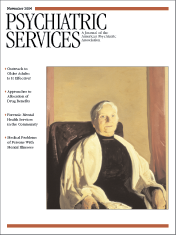Smoking Cessation Services in U.S. Methadone Maintenance Facilities
Abstract
OBJECTIVES: Most patients in drug treatment smoke cigarettes. This study established the prevalence and types of nicotine dependence services offered in methadone and other opioid treatment clinics in the United States. METHODS: A cross-sectional survey was conducted of all outpatient methadone maintenance clinics in the United States. One person in a leadership position from each clinic was surveyed. The 20-minute survey was collected by phone, fax, or mail, according to responder preference. RESULTS: Fifty-nine percent of the clinics (408 of 697 clinics) responded. The sample was very similar to all outpatient methadone maintenance clinics in the United States in size, region, and ownership. In the 30 days before the survey, respondents reported that their clinics provided the following services to at least one patient: 73 percent provided brief advice to quit, 18 percent offered individual or group smoking cessation counseling, and 12 percent prescribed nicotine replacement therapy. However, the services were provided to very few patients. Clinics with written guidelines that required them to address smoking were much more likely to provide services than those without guidelines. Private for-profit clinics were significantly less likely than public or private nonprofit clinics to treat nicotine dependence. Most respondents (77 percent) reported that their staff were interested in receiving training in nicotine dependence treatment, and more than half (56 percent) had at least one staff member ("champion") with a strong interest in treating nicotine dependence. CONCLUSIONS: A vast majority of methadone patients smoke; yet in the 30 days before the survey only one out of three facilities provided counseling to any patients and only one out of ten prescribed nicotine replacement therapy to any patients. A dual strategy of requiring clinics to provide comprehensive nicotine dependence services and training staff to provide these services may provide the incentive and support necessary for the widespread adoption of treatment for nicotine dependence in methadone facilities.



